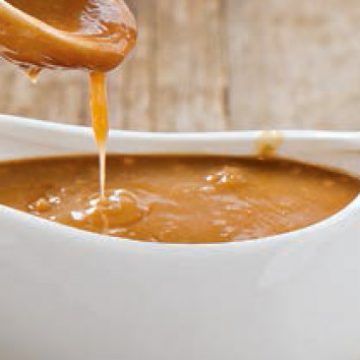With the winter weather comes the welcome excuse to tuck into more comforting fare. Whether you’re indulging in a regular ol’ Sunday roast chicken or prime rib, or a special holiday turkey dinner, can’t we all agree that what brings it all together is a proper gravy? Really, what are mashed potatoes, or stuffing, or Yorkshire pudding if not vehicles for getting more gravy in your gullet? Even when it’s bad, it’s still pretty good. But for those of you who’ve long settled for a package of brown powder mixed with fatty meat drippings, you ought to know that delicious gravy is incredibly easy to make from scratch.
One of my earliest kitchen memories is helping my mother make the gravy for family roasts. My task was to whisk the roux, which is the base for most classic French sauces. There’s an art to cooking a roux, as it requires a keen eye: the flour will bubble and start to cook with the fat as you stir. It takes a bit of waiting for it to reach the right shade of caramel before stirring in your liquid, but it will burn soon thereafter.
My mother taught me that any gravy is made up of three basic building blocks: fat, starch and stock. If you’re roasting your meat, the best flavour comes from the savoury fat and drippings that collect in your roasting pan. But you could still make a serviceable gravy with some butter, flour and a can or cube of meat stock, and nobody would complain.
This is my mom’s recipe for a basic gravy that can be adapted for any meat — use a chicken stock for roast chicken and turkey, or a beef stock for beef (pork can go either way). Play around with layering in different flavours — some wine or Worcestershire sauce for acidity and tang, peppercorns for added zing or just salt and pepper to taste (my mother always splashed in whatever wine we were drinking with the meal, and some soy sauce in lieu of extra salt to build in some colour). Feel free to make this recipe your own, and make extra — leftover roast turkey demands gravy for a hot, open-faced sandwich, or even as a spread for a cold one. Once you’ve perfected your own secret recipe, you can toss that package of Club House gravy mix for good.
Mrs. Chan’s basic gravy
Yields 500 ml (2 cups)
- 60 ml (4 tbsp) fat — from your roast, separated from drippings, or butter or lard
- 60 ml (4 tbsp) all-purpose flour
- 500 ml (2 cups) meat stock, or a mix of roast meat drippings, separated from fat, with the remainder made up from stock
- Splash of red wine (optional)
- Dash of Worcestershire sauce (optional)
- Dash of soy sauce (optional)
- Salt and pepper to taste*
* Taste your gravy first, especially if using canned or cubed stock, as they tend to contain loads of salt already.
- Have your stock and drippings measured out; keep close by. In a medium saucepan, start your roux by heating the fat on medium-high heat. Add the flour and quickly begin to whisk, moving the mixture around constantly. Continue to do this until you see the roux turn a rich caramel colour — you’ll also be able to smell the difference as the flour begins to brown and the rawness cooks out.
- Continue to whisk with one hand while gradually pouring your stock into the pan, keeping everything moving until the liquid is completely blended into the roux.
- Bring the gravy to a boil. Then reduce to a simmer to thicken. Add red wine, Worcestershire sauce, soy sauce, salt and pepper to taste. If you like a thinner gravy, you can add additional stock to loosen it up. The gravy can sit, covered, until you’re ready to serve — just remove any skin that’s formed on top and reheat gently.
Sara Chan is a Toronto-based entertainment lawyer, food enthusiast and unprofessional home chef. Her favourite food group is pork.
Photo: iStock


